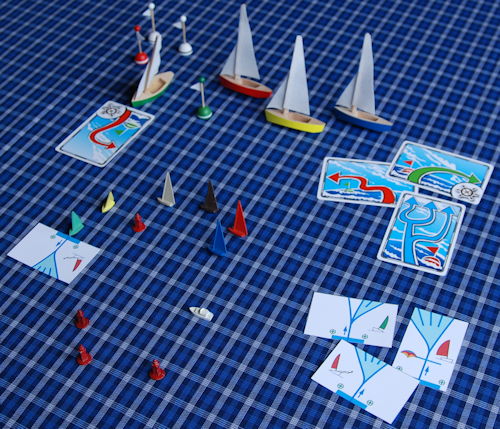
The large Gigamic boats, buoys and cards and the small 3M ones. Note the chequered table cloth.
Author:
Lutz Pietschker
Version: 2011-03-01
Games | Home Page | Version History
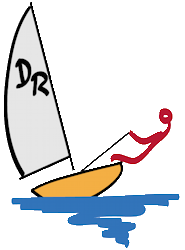
You can consider Dinghy Race a new game, but you could also consider it a variant of Regatta (3M 1967, Jerry & Dave D'Arcey, Frank Thibault) or Regatta (Gigamic 2010, Emmanuel Fille & Martine Moisand) because you need some components from either of these games; to be precise, you need the boats and the turn marker buoys if you do not want to make your own. Both games come with boats that do not stand quite upright, but are always tilting either to the left or the right side, and this is a feature we need in this game– more on that later.
The idea is to simulate a sailboat race in a playable format, keeping physics intact (the basic version of the Gigamic game fails on this account), and reducing the chance factor to a degree that gives decisions the priority over pure luck (which is one thing where I feel all existing games fail to some extent). The mechanics are similar to miniatures-type games; you do not play on a board with fixed spaces, but on a plain surface, with movements restricted only by the manoeuvre cards you can play.
This is a work in progress, the rules have not yet been tested to an extent where I could be confident that they are the best possible. I am open to any suggestions to change them. In particular, this applies to the chance values on the hazard tables. Please send me a mail if you have any comments.
Overview & Material – Rules – Regatta Courses – DIY Boats – Credits & Version Info
Each player is the skipper of a dinghy (a small sailboat without a fixed and weighted keel) in a regatta, a boat race. Boats are moved by means of manoeuvre cards and according to a small set of rules (do's and don'ts, right of way etc.). They sail along a course set out by buoys that must be passed in a prescribed order; the first boat to cross the finish line wins. Besides setting the best course, players have certain tactical options by playing "Lady Luck" cards to handle risks and "weather eye" cards to influence the wind to their advantage.
In the text you will sometimes encounter boxes formatted like this one. These are design notes, explaining the rationale behind a rule or procedure. You do not need to read them to play.
I'll start with a bow to other sources that gave me the inspiration for these rules: In addition to the Regatta games mentioned above, this is mainly Wings of War, a dogfight simulation by Andrea Angiolino and Pier Giorgio Paglia in which you move aeroplanes by cards very similar to the manoeuvre cards in this game. A discussion in the Wings of War forum on the Boardgame Geek website started a train of thought that has lead me here. See the credits for other people who helped me.
Contrary to many other sailing race games I know, Dinghy Race has no rules for changes of wind strength and direction during a race. In my opinion such changes just introduce blind chance and do not help in a race simulation. I also omitted rules about blanketing because they would add a lot of complications while doing little to focus on the real issues involved in racing.
That said, the game is focused on buoy tactics, right of way tactics and "sniffing" good local wind conditions (see "weather eye"). My sailing friends tell me that this is what they concentrate on. The hazard tables add an element of resource management; in an abstracted way, the "Lady Luck" cards represent the good judgement of a skipper about when to stay cool and when to accept risks.
Sometimes you will see boxes are formatted like this one; they show examples for a rule just explained.
You need
You can download the card sets here:
Use the small cards if you play with the 3M boats, the standard-sized cards if you play with the Gigamic boats. The round markers are alternatives to some of the cards (you could place them on your turn order card to indicate the boat's status), use whatever you prefer.

The large Gigamic boats, buoys and cards and the small 3M ones. Note the chequered table cloth.
Small cards are 67 x 43 mm, standard cards (Gigamic) are 89 x 58 mm in size. See the DIY section for boat sizes.
The game tries to simulate a sailboat race or a regatta (technically, a regatta is a series of races that must be completed to win one event), so you need to know some sailing concepts and terms, or the rules will make no sense.
The port side of a boat is the left side, seen in the direction of sailing (i.e. from the end of the boat (the stern) to the front (the bow); starboard is the right side. The designating colour for port is red, the one for starboard is green.
At any time in the game, the wind will come from either the left or the right side of the boat, heeling the boat to the opposite side.
Which tack a boat is on is very important for manoeuvring and for the right of way in certain situations. I will use the terms starboard tack and port tack from now on.
In the image above, the red, yellow and blue large wooden boats are on the port tack (heeling to the right), the green one is on the starboard tack (heeling to the left). The small green and yellow boats are also on the starboard tack, though it is a bit hard to see for the green one.
 A boat on the starboard tack has the wind from the right (starboard) side, and the boom and sail stand to its left side. It also heels to the left side, if at all.
A boat on the starboard tack has the wind from the right (starboard) side, and the boom and sail stand to its left side. It also heels to the left side, if at all. A boat on the port tack has the wind from the left (port) side, and the boom and sail stand to its right side. It heels to the right side.
A boat on the port tack has the wind from the left (port) side, and the boom and sail stand to its right side. It heels to the right side.A synonym for "port" is "larboard". I do not use it in the rules; this remark is just to add to the confusion:-)
A note for German sailors: Port tack is the same as "Backbordhalsen" = "Steuerbordbug". Starboard tack
is the same as "Steuerbordhalsen" = "Backbordbug". The difference between continental and British/US nomenclature confused me in the first version of these rules.
Boats behave very differently at different angles to the wind; the angle between the boat's keel and the wind line is called the wind aspect or point of sail. For the purposes of the game we distinguish these points of sail:
A boat that points exactly along a sector border may choose which sector to apply. Note that even on a 180° (flat before the wind) course the boat is always considered to be on one specific tack.
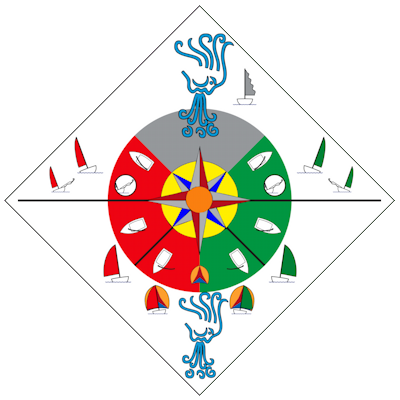
The symbols outside the coloured sectors are the same as shown on the manoeuvre cards; in any wind aspect, only manoeuvre cards showing that symbol may be played. The symbols show a boat with that wind aspect as seen from behind. Boats on the left side of the diagram (marked red) are on a starboard tack, those (green ones) to the right are on a port tack.
There are also names for course changes:
These are two common manoeuvres that need a special mention; they are manoeuvres that win or lose races. Both change the wind aspect in a way that the boat moves to the other tack: If it was on the starboard tack before, it is on the port tack afterwards, and vice versa. To change the tack a boat is on you must perform one of these manoeuvres.
Of course, any old sailor will tell you that you also need to know hundreds of other terms, dozens of knots and hitches, some rare old customs (strangely, many of them having to do with drinking) and probably a few shanties thrown in for good measure. For this game, you don't.
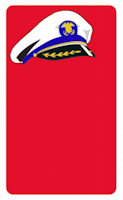 Round and Turn Sequence
Round and Turn SequenceThe game is played in rounds; five pre-start rounds are followed by as many rounds as needed to complete the course.
In each round, every player has one game turn. The turn order for the players is determined before the start but will probably change in the course of the game; mark the turn order by laying out the turn order cards (in the colours of the boats, see image to the right) in turn order.
In his turn, each player
After all players had their turn, all weather eye markers drift downwind, and a new round begins.
 Wind
Wind The game assumes that both the wind direction and its force remain constant for the duration of the race. It only distinguishes three different wind forces: Light wind (1-2 Beaufort, hazard table marked with 1 wind symbol), medium wind (3-4 Beaufort, 2 wind symbols) and strong wind (5-6 Beaufort, 3 wind symbols).
Wind force does not influence movement; its only effect is a varying risk involved in certain manoeuvres; the stronger the wind, the higher the risk. See the "Hazard" section for details.
In dead calm few races are even finished, and in storm conditions races are usually cancelled for safety reasons, and both is not much fun in game terms; hence the limitation to "sensible" wind forces. Otherwise the rules assume that all skippers have equal boats and sails, so the important part of the movement is the relative speed of the boats, achieved through good manoeuvring. The game has no "absolute" speed, length or time scale.
Use a chequered (plaid) table cloth if possible, this makes it very easy to see the boats' aspect to the wind and to distinguish the sectors shown in the wind marker.
Now get the skipper's equipment:
Now shuffle the turn order cards and put them face-up in a row to determine the turn order for the start. The boat in the colour of the leftmost turn order card goes first, the others follow in the order of the cards from left to right.
Mark the start line by two buoys (or the bow of a start ship and a buoy). Make it wide enough for all boats to pass through, i.e. at least one full card length per boat in the race.
If you play with small cards and 5 boats, this would make it 67 x 5 = 335 mm of clear space between the buoys. Or 13.7", or about 1', or 1/6 fathoms if you prefer inching along ye olden units.
In turn order, each player puts his boat in a position of his choice downwind of the start line and places one manoeuvre card of his choice in front of it, face-down; both the boats and their cards must stay downwind of the line at all times during the pre-start turns. Place your boat with an aspect to the wind of your choice; the movement card, of course, must fit that aspect. Boats must be placed in a way that they and their manoeuvre cards do not touch or overlap buoys or other players' boats or manoeuvre cards.
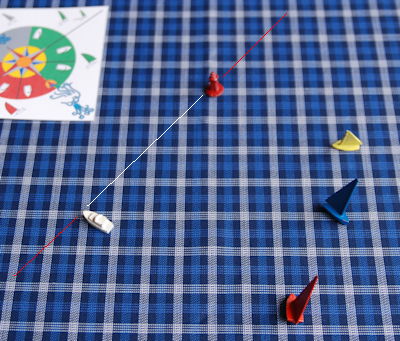
The white line is the start line, usually perpendicular to the wind. Together with the red lines it marks the allowed start positions; positions downwind of this line are OK, upwind positions are not.
Players now begin to move their boats for the pre-start rounds, observing all normal rules with these exceptions:
Boats may cross the start line in round 6, which is the first regular round of the race; from the beginning of that round all manoeuvre cards are legal.
Turn order may change on pre-start turns by the usual rules (see right of way). When a player touches the start line before round 6, he must remove his boat place it again at a position of his choice, but at least as much to leeward (downwind) as the boat that is farthest to downwind at this moment. He must then place a delay card as his manoeuvre for the next turn.
Crossing the start line changes the turn order: The first boat (the actual boat, not its manoeuvre card) to cross the start line becomes #1 in the subsequent turn, the next #2 etc.; re-arrange the turn order cards accordingly.
When the last boat has started, remove the start line.
Pre-start manoeuvring is an important part of competitive racing; a good start puts you in a very good position for the first leg of the race.
The Manoeuvre Cards – Movement – Tacking and Jibing – Delays – Spinnaker – Trapezing – Right of Way
All players have an identical set of manoeuvre cards to move their boat. Some cards are played with their long side parallel to the boat, others are played with their short side parallel to the boat. Each card indicates in which situation it may be used; the factors are wind aspect, whether you are trapezing or not (applies only when close-hauled) and whether you fly a spinnaker (applies only when running).
When playing the card in front of your boat, place the card face-down with the short or long parallel to the boat, just as the card will later be placed when face-up; the bow should point to the middle of the card. When using it to move the boat, place it so that the bow touches the entry line, adjust sideways for special advantages (see "Weather Eye") and move the boat so that the stern touches one of the exit lines and the hull is parallel to the exit line.
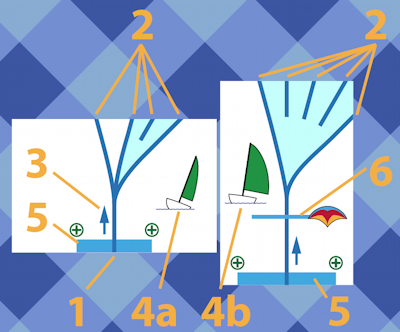 The image to the right shows the elements of manoeuvre cards:
The image to the right shows the elements of manoeuvre cards:
The point of sail (wind aspect) symbols are the same as those on the wind compass. They show the boat as seen from behind, and you can actually compare them to the boat on the table to see whether you apply them to the correct aspect (see movement example below).
The tack and jibe cards show two entry condition symbols because they can be used for boats on any tack and two exit symbols as a reminder that these cards change the tack you are on.
The exit lines are the only possible exit points of the cards; as they are always in multiples-of-15°-steps, the boat will always be on a course that is an exact multiple of 15°. The fact that the left card shows no blue sector between the two leftmost exit lines is just a visual reminder that there is no "straight" exit line on this card.
You always have your full set of manoeuvre cards available (except for the one card already placed in front of the boat). The restrictions on card play are:
Cards that may be played twice in succession are available twice in the manoeuvre deck. Here is an overview of all manoeuvre cards a player has (a total of 17 cards):











Gallery of manoeuvre cards, in the order described above
In addition, each player has a "trapezing" marker card and supply of weather eye and Lady Luck cards.
You move your boat by playing manoeuvre cards in front of your boat. You start the game and every turn with one card in front of the boat (exception: boat dead in water); each turn follows this sequence:
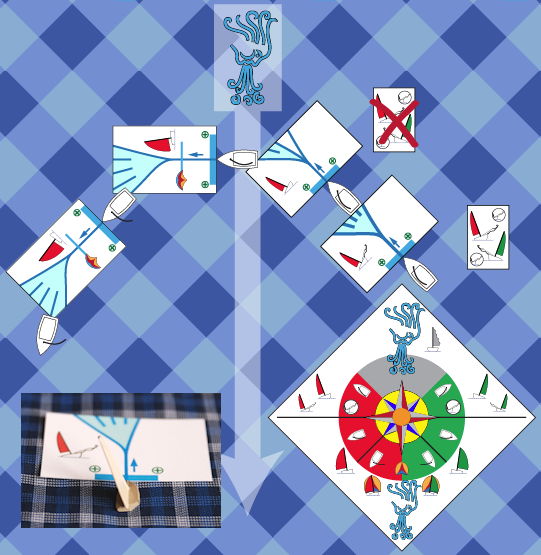 The image to the right shows a series of moves to explain the concept. The boat starts on a close-hauled course on the starboard tack, using the trapeze. It removes the trapeze and and falls off to a running course over 4 consecutive player turns:
The image to the right shows a series of moves to explain the concept. The boat starts on a close-hauled course on the starboard tack, using the trapeze. It removes the trapeze and and falls off to a running course over 4 consecutive player turns:
See the "Right of Way" section to resolve manoeuvres that bring boats into conflict with other boats or their manoeuvre cards.
If the movement card in front of the boat can be played legally it must be executed, the commitment to the manoeuvre cannot be taken back. However, you decide the details of the movement (which exit line to use) only when actually moving the boat.
Playing an illegal card, i.e. a card for which your boat does not meet the conditions to play it, implies a penalty. The illegal card is immediately replaced with a delay card which you then execute; in effect, you play a delay instead of your intended manoeuvre.
It is up to the other players to see to it that you execute your manoeuvre correctly, for example that you do not use advantages you are not entitled to. Any player may protest an illegal move. Once the player has completed the move and removed his just-used movement card, the move cannot be changed, even if it was illegal.
Examples of illegal play are: Playing a card with "trapezing" condition while not in trapeze, playing a close-hauled card while reaching or running or vice versa. Apply common sense, in particular with inexperienced players. I advise to apply penalties only if the illegal card could possibly have given an advantage to the player; for example, to play "spi down" on a running course but without actually flying a spinnaker is a disadvantage because of the fewer exit options, so I would not punish a player for using it out of context.
Of course millimetric precision is not possible with this movement system, contrary to games with game boards where squares or hexagons regulate movement. However, the fact that all possible courses are exact multiples of 15° helps. Otherwise, place the cards and move the boats to the best of your ability; if you find that someone tries to cheat, your best option is to avoid playing with that person. I assumed that the spirit of the game is fair competition.

 Tacking and Jibing
Tacking and JibingBoth manoeuvres bring the boat from one tack to the other, i.e. from port tack to starboard tack or vice versa. Playing them commits you to perform a change from one tack to the other:
Whenever a boat changes the tack it is on, do not forget to put the boat figure to the correct heel.
Through fanciful manoeuvring you can cause a tack or a jibe without playing a tack or jibe card; such manoeuvre is called an involuntary tack or jibe. It is not illegal but implies a greater risk (see example below).
Tacking and jibing are potentially dangerous manoeuvres. After each such manoeuvre, voluntary or involuntary, look up the hazard table, roll the dice if necessary and apply any penalty listed there.
An involuntary tack or jibe implies the normal hazards, but modified with a -2 modifier (a malus) on the die roll, and it automatically voids any possible bonus move.
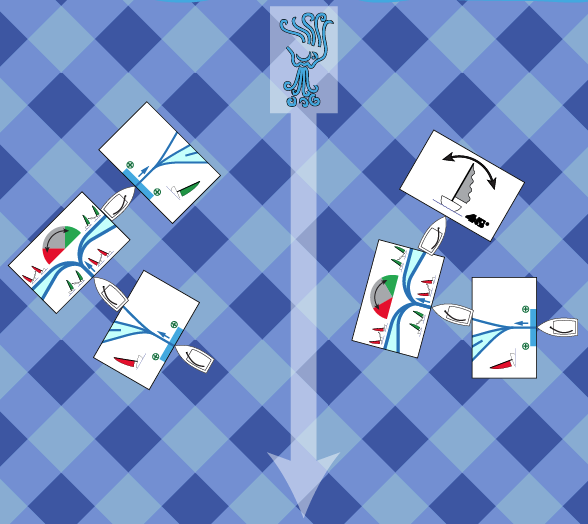 Examples of going about, the left one perfect, the right one not-so-perfect:
Examples of going about, the left one perfect, the right one not-so-perfect:
In the left example the boat starts with a course of 60° to the wind on the starboard tack. The manoeuvre card changes the course to 45° to the wind, the best a boat can do in this game.
The tack now puts the boat on the other (port) tack with the choice to have a 45° or 60° course on that tack; the skipper decides for the 45° course as he would usually do when trying to sail against the wind on the best possible course. Note how the entry and exit symbols indicate the change of the tack.
The next move is again in a close-hauled point of sail, but this time on the port tack, with the appropriate movement card.
What went wrong in the attempt shown right? The boat started at 90° on the starboard tack and went to 75° with the first move. It then took a sharp turn, but this turn did not bring him around quite as far as necessary, i.e. to 30° instead of the 45° minimum. He ends up "in irons", in the gray sector of the wind compass, and the only manoeuvre card he can play now is the delay card.
He can use his next turn to turn the boat in place 15° clockwise, bringing him on a legal close-hauled course again and enabling him to place a "close-hauled, port tack" manoeuvre card in front of the boat for the next turn.
We learn: You can tack successfully from an angle of 45° or 60° to the wind, the "sharp turn" exit line on the tack card makes that possible. Note that once the player had placed the tack card he is committed to perform the move, even if he notices that it was a bad idea before actually executing the move.
In any case, the skipper would have to make a hazard roll for the turn. Since he is not using the trapeze while going about, the worst that could happen to him in any wind is a delay (a 3% chance in low wind, an 8% chance in medium and a 17% chance in strong wind). He could play Lady Luck cards to diminish or eliminate that risk.
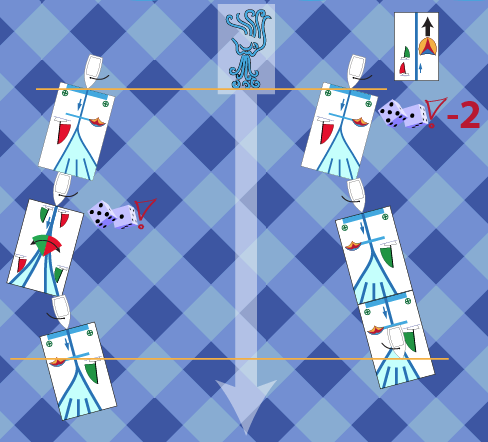 Examples of jibing, different skipper personalities involved:
Examples of jibing, different skipper personalities involved:
To the left you see a standard, conservative jibe manoeuvre. It puts the boat from a running course on the starboard tack to a running course on the port tack. The boat has to take a hazard die roll before executing the jibe card, but assuming that he is not flying a spinnaker, the worst risk the skipper faces is a 3% or, in medium and strong winds, an 8% chance for a delay.
To the right you see a bit of sharp to desperate sailing. The skipper performs an "involuntary" jibe (accidental jibe, German "Patenthalse" in sailor's terms, though in the example he probably does it consciously) while flying the spinnaker (read the spinnaker chapter first if you did not do so yet). This is not an illegal move, but it changes the risk he takes on the hazard rolls considerably:
All this risk for gaining an advantage of one spinnaker bonus! Note that the skipper does not get the spinnaker bonus for the jibe turn because involuntary manoeuvres cancel such advantages. The turn after the jibe is not affected and gets the bonus. Also note the fine difference between "involuntary" and "illegal": An involuntary manoeuvre in itself just cancels any bonus, while an illegal manoeuvre causes delay. The manoeuvre here was legal, because the player was, by the symbols on the card, entitled to play the card; just the course he chose lead to involuntary jibe.
Of course, if you feel that you must make such a move (seen too many swashbuckling Errol Flynn movies?), it would be a prime opportunity to employ the services of Lady Luck.
 Delay Cards
Delay CardsThese cards may be played for any point of sail,
When played voluntarily, place the delay card in front of your boat normally (face-down). When you reveal the card, simply remove it and end your turn by playing a new card.
When played as a penalty or as a hazard result, more than one delay cards may be placed face-up in front of your boat, replacing any card that may have been there. Each turn, remove one delay card. When the last card has been removed, play a new manoeuvre card as usual and end your turn. You are in the race again.
A delay card automatically and immediately removes any "trapezing" or "spi up" status a boat may have.
You are allowed to perform one 45°-turn whenever "executing" (revealing or removing) a delay card; if this pivoting changes the tack the boat is on, adjust the heel of the boat (it is an automatic tack or jibe, not an involuntary one, and it does not involve a hazard die roll). You are not allowed to otherwise move the boat in a delay turn, but it is not considered "dead in water".
 Using the Spinnaker
Using the SpinnakerThe spinnaker ("spi", for short) is a balloon-shaped sail that can be set on all "running" courses, i.e. when the boat sails before the wind inside the 90°-sector indicated on the wind compass. It gives the boat a speed advantage at the cost of some additional equipment handling.
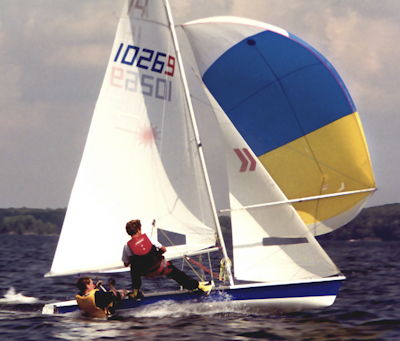
The white-blue-yellow spinnaker sail on a Laser-class dinghy. It looks as if this crew flies the spi on a course that is not really "before the wind", but the picture nicely shows the necessary equipment and handling effort: You need a halyard to hoist it, two sheets to fly it, and a boom to stabilise it to windward. Not the least of tasks is to take it down again when changing the course to windward, in particular because this tends to happen in situations that are also otherwise demanding, like rounding a buoy. Handling all this puts additional load on the crew and adds to the possibility to make mistakes; hence the hazard die roll. (Image Source: Wikipedia)
To set the spinnaker and to take it down again you play special manoeuvre cards; one card is provided for each manoeuvre. When you set the spinnaker, place the "Spi up" card you just executed in front of you, face-up, to indicate the "spi up" status (i.e. this manoeuvre card doubles as a status marker). Take it back into your manoeuvre card deck after you have completed a "spi down" manoeuvre or after another event (e.g. delay card) has removed the "spi up" status.
Note that both manoeuvres require a die roll on the hazard table and that, by playing a "spi up" or "spi down" card, the player commits himself to actually hoist the spinnaker or take it down, this action is not optional once the card is played.
While the spinnaker is up you have an optional movement advantage: Move the boat in a straight line after the movement indicated by the manoeuvre card; use the "spinnaker bonus" line on the card to determine the length of this extra move. You can only use this advantage if the card you played has a "spi advantage" line.
Abuse: Continuing to fly the spinnaker on any reaching or close-hauled course has the following consequences:
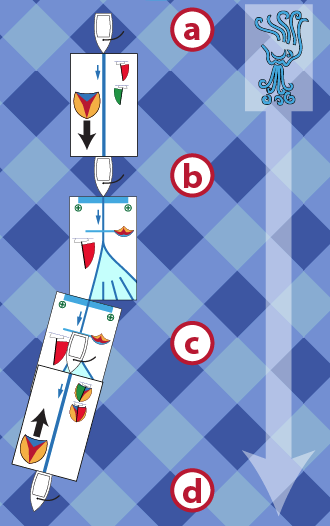 Spinnaker example: The boat is running before the wind with the spinnaker down; let us assume it is on the starboard tack. When it reached (a), the skipper placed the "spi up" manoeuvre card for his next turn.
Spinnaker example: The boat is running before the wind with the spinnaker down; let us assume it is on the starboard tack. When it reached (a), the skipper placed the "spi up" manoeuvre card for his next turn.
Executing the "spi up" manoeuvre brings the boat to (b); after your turn, put the "spi up" card visibly on the table to mark that your boat is flying its spinnaker now. Place one manoeuvre card in front of the boat as usual.
Next turn the boat sails under spi and may execute a movement with a bonus: After the regular move (in our example, luffing a bit), place the same card (or better the second card of the twin pair) at the exit line you want to use. Place the boat with its stern to the spi bonus line, as shown. The boat is now at (c). Now you can remove the original manoeuvre card; because it was only an auxiliary card for the last move, you may even place it in front of the boat for the next turn, if you wish.
Our skipper then decided to take the spi down again in the next manoeuvre.
Next turn he executes the spi down manoeuvre, which brings him to (d). He also takes the "spi up" card into his card hand again.
As shown, this manoeuvre gained him about one third of a card's length for two risky manoeuvres. In light wind, the risk would be 3% (one roll < 3 when taking the spi down), in medium wind it would be two chances of 8% each and in strong wind one chance of 8% and one of 28% to get at last one delay. Which shows that you should normally only set the spinnaker when you expect to use it for more than one turn.
I am aware that modern spinnakers can be set at least at reaching courses, in particular the asymmetric ones. In this game I assume a more classic type of spinnaker that can only be used on running courses.
By the way, the origin of the word "spinnaker" is unknown; it may be connected to an old Scottish word "speen", meaning to drive before a strong wind, but other opinions as to its origin exist.
 Trapezing
TrapezingThis is a sailor's term for use of the trapeze, a contraption that lets you put your weight out very far, thus counteracting the wind that tries to heel the boat.
A boat sails best when the mast is vertical; this exposes the maximum effective sail surface to the wind to drive the boat, and the maximum underwater surface (i.e. the hull and the daggerboard) to prevent it from drifting off to leeward. Another word for trapezing is "hiking".
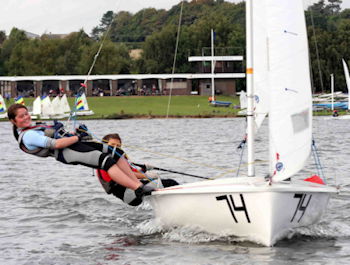
Holding the boat on an even keel by using the trapeze. Wet work, but believe me, this is a lot fun when crew and skipper work together well!
 The trapezing marker shows your status: If this card is face-up on the table, you are using the trapeze, if it is face-down, you are not. To go into trapezing mode, you must declare this at the start of your turn. If your the manoeuvre card placed in front of your boat is a card showing the "boat with trapeze" symbol, you may take advantage of the trapeze, otherwise you may not.
The trapezing marker shows your status: If this card is face-up on the table, you are using the trapeze, if it is face-down, you are not. To go into trapezing mode, you must declare this at the start of your turn. If your the manoeuvre card placed in front of your boat is a card showing the "boat with trapeze" symbol, you may take advantage of the trapeze, otherwise you may not.
To remove "trapezing" status you simply declare it at the start of your turn and flip the marker over to its back side. Note that you need to plan this one turn in advance, because playing a manoeuvre card that shows the trapeze symbol without actually being in the trapeze is illegal (see "Movement", above).
Abuse: Using the trapeze (i.e. having the trapezing marker face-up) in a reaching or running wind aspect has the following consequences:
There is no penalty for using the non-trapeze variety of the close-hauled manoeuvre cards while actually being in trapeze.
Trying to go about without removing the trapezing marker first is allowed, but implies a greater risk on the hazard table.
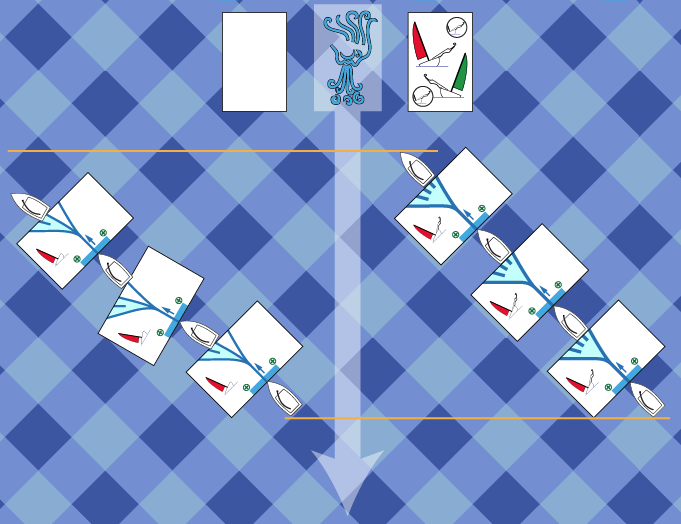 The difference between "trapezing" manoeuvre cards and "non-trapezing" ones is subtle: You cannot (in this game!) sail a straight line on a close-hauled course without the trapeze, you would be forced to sail along a "wavy" line. As the example shows, this costs you some progress to windward, an effect that makes itself felt even on a few turns.
The difference between "trapezing" manoeuvre cards and "non-trapezing" ones is subtle: You cannot (in this game!) sail a straight line on a close-hauled course without the trapeze, you would be forced to sail along a "wavy" line. As the example shows, this costs you some progress to windward, an effect that makes itself felt even on a few turns.
The low "cost" for using the trapeze is a reflection of the fact that most boats can sail a 45° course against the wind, or even better.
Right of way is not just a traffic control concept in a boat race, to know these rules and to apply them is an essential tactical weapon in your arsenal. It is not dishonourable to sail in a manner that gives you the right of way in certain situations, forcing your opponent to give way and possibly changing his position in the race to the worse (of course this does not include the right to cause damage). The points were these rules are most important is when it comes to rounding the buoys. The chapter in the official rules that is best applicable to this game is aptly titled "When Boats Meet".
Right-of-way rules apply in the following situations:
Right of way never applies once a boat has completed its move; the boat (not its manoeuvre card!) then acts like a fixed obstacle until its next turn, you can neither move through it nor place a manoeuvre card on top of it. Right of way or not, you cannot just sail through it or plan your next manoeuvre through its position ("...no right too cause damage...", remember?).
In such cases the acting player must, if possible, use an exit line that does not cause boat-to-boat conflict. If this does not solve the problem, he must stop the execution of his move in a way that his boat does not touch the other boat, still keeping the direction of one of the possible exit lines.
When the player has completed his move and would be forced to play his manoeuvre card for the next turn on top of another boat, he places the card beside the boat (this card may be shifted around as necessary; technically it does not take up table space– its only function is to commit the player to a certain manoeuvre). When it is his turn again, he tries to place the card and, if this is possible now, plays his turn normally. If he is still not able to place the card (because the same or another boat is still in his way), he exchanges the manoeuvre card for his delay card, places that aside and waits for his next turn again.
The remaining conflicts resolved by right-of-way rules are
Swapping turn order positions means that you exchange the positions of the turn order cards. No player loses a turn by doing so; when the acting player is done, the next player is simply the one with the leftmost unused turn order card (you see that it is useful to mark who has already done his turn).
Use the following rules to determine which boat has the right of way; use only the first rule that applies:
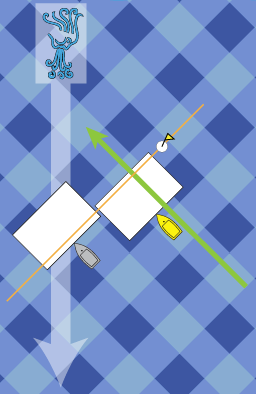 The "inner boat rule" in round-the-buoy conflicts (rule 3., above) assumes that there is a "best course" towards the buoy that both conflicting boats share, this is the green line in the example. "Best" is defined as the best direction any boat could take from the previous buoy to the one in question. In case of an upwind leg, this would be one of the 45° courses bordering the "in irons" sector because no boat can sail closer to the wind than that.
The "inner boat rule" in round-the-buoy conflicts (rule 3., above) assumes that there is a "best course" towards the buoy that both conflicting boats share, this is the green line in the example. "Best" is defined as the best direction any boat could take from the previous buoy to the one in question. In case of an upwind leg, this would be one of the 45° courses bordering the "in irons" sector because no boat can sail closer to the wind than that.
The rule takes effect if a line drawn through the buoy, perpendicular to the best course (the yellow line in our example), touches the manoeuvre cards of more than one boat that are on a course to round that turn marker, and one of the outer boats has its turn. The innermost boat (only) can then demand immediately, though it is not active right now, to swap turn order positions with the outer boat whose turn it is. If it does, swap the turn order cards as described above immediately. After that, the active player continues with his turn as usual.
The innermost boat can demand the swap at any time during the active player's turn, so the manoeuvre card considered for the active player could be either the one he is just executing or the one he places for the next turn.
Note that boats that have already rounded the turn marker on this leg of the race, or have not yet completed the previous leg, are never considered for the purposes of this rule. Note also that the "on different tacks" rule (rule 2., above) takes precedence over the rule discussed here.
If you think this rule is too fiddly, please feel free to ignore it. The rule is meant to reproduce the "overlapping boats in turn marker zone" rule of real-world racing rules.
The following rule does not establish a right of way but prescribes a certain behaviour that must, in cases of doubt, be judged by the Race Steward (the host of the race, if you did not decide otherwise):
Right of way rules for real sailboat races are quite complex, my right-of-way rules reflects only the most important ones in a format that makes sense (I hope) in a game like this. If you want to know more about those rules, look up Wikipedia, or the official Racing Rules of Sailing on the pages of the International Sailing Federation (ISAF).
Certain manoeuvres and actions are potentially risky, and the more so the stronger the wind is. After each manoeuvre listed on the hazard card and not marked "-", roll both dies and apply the total result. Possible results are:
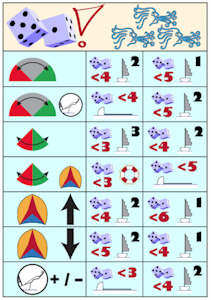
 Man over board: Do not complete your manoeuvre. Instead, turn the boat by 180 degrees (so it points back to where it came from) and then put the boat on one side (player's choice). Next turn you put the boat upright again without changing its direction, using the correct heel for its current wind aspect. The turn after that you start again as indicated in the "Boat Dead in Water" section.
Man over board: Do not complete your manoeuvre. Instead, turn the boat by 180 degrees (so it points back to where it came from) and then put the boat on one side (player's choice). Next turn you put the boat upright again without changing its direction, using the correct heel for its current wind aspect. The turn after that you start again as indicated in the "Boat Dead in Water" section.The example shows the hazard table for strong wind; which table you apply is decided upon during the preparation for the race. The stronger the wind, the more dangerous the manoeuvres get. Only one hazard is ever applied on a hazard check, never both.
Read the table like this: If you had tried a jibe without taking the spinnaker down before (4th row of the table), you lose a man over board if you roll less than 4 (i.e. a 2 or a 3– you cannot roll a 1 with two dice); ignore the "capsize" hazard to the right in this case. If you roll 3 or more and escape the first (leftmost) risk, check the next hazard to the right, using the same die roll end result: If you rolled a 4 ("<5"), your boat capsizes. If you rolled 5 or more, your gamble paid off and nothing happens.
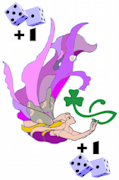 Lady Luck
Lady LuckBefore any hazard die roll you may commit as many of your "Lady Luck" cards as you like; each card played adds 1 to your die roll result.
You start the game with a certain supply of "Lady Luck" cards; spent cards are out of the game and may not be used again, even if they did not actually change the net result. Management of your allotment of luck is part of the game tactics.
 This example shows "Lady Luck" in action. The skipper wanted to try a tack with a fast-trapeze action (2nd table row) in spite of the high winds, and he committed one Lady Luck card. Good idea, as it turns out: He rolled a 3, which becomes a 4 with the luck card bonus. This means he avoided capsizing (4 is not "< 4"), but instead he is affected by a 2-turn delay (because 4 is "< 5").
This example shows "Lady Luck" in action. The skipper wanted to try a tack with a fast-trapeze action (2nd table row) in spite of the high winds, and he committed one Lady Luck card. Good idea, as it turns out: He rolled a 3, which becomes a 4 with the luck card bonus. This means he avoided capsizing (4 is not "< 4"), but instead he is affected by a 2-turn delay (because 4 is "< 5").
As the chance table shows, playing Lady Luck changed his chance to capsize from 8% to 3% (only a snake-eyes roll would still have got him) and his chance to get away completely unscathed from 83% (100-17) to 92% (100-8).
When the first boat begins the last leg of the race, set up the finish line (use two buoys, or the start ship and a buoy, as you did for the start line).
Each boat finishes the race the moment it touches (or moves beyond) the finish line; the boat itself counts, not its manoeuvre card. The boat is then removed from the game immediately; you do not wait until the current round is finished. The player whose boat finishes first wins; other players win the second, third places etc. as their boats finish.
For the lawyers: A boat must have rounded all buoys in the correct manner and order as demanded in the course description to be able to finish the race.
If the race is part of a series, you may want to award points to the skippers; the total of points after at the end of the regatta determines who won the series. You may award 10 points to the winner and one point less for each following place, down to 5 points for 6th place, or something similar.
The 10-9-8-7-6-5 rule quoted above is from the 3M Regatta game, only, in a bout of generosity, they made it 1000-900-800 etc. points.
The Racing Rules of Sailing mention a "low point system"
and a "bonus point system". Both have in common that the boat with the lowest total score wins. Under the low point system, boats get 1-2-3-4-5-6 etc. points for the races, under the bonus point system it is 0-3-5.7-8-10-11.7 for the first six places. In both systems each boat can usually ignore its worst race result in a series. Ties are broken by listing the scores race by race; the first un-tied race result wins the overall tie.
In Formula 1 car racing they currently use a 10-8-6-5-4-3-2-1 system; before that, they used a 9-6-4-3-2-1 system.
Usually the person or organisation that hosts the regatta determines which scoring system shall be used.
Dead in Water – Weather Eye – Obstacles
These rules have been taken out of the above sections because they describe special situations that do not occur that often, or special concepts like "weather eye".
A boat is dead in the water when it starts a turn without a manoeuvre card in front of it. In its turn, such a boat may make a 90°-turn in either direction and may then place, face-down, any manoeuvre card in front of the boat that fits the current boat aspect, to be executed next turn as usual. Note that delay cards fit any wind aspect.
A boat dead in water is treated as an obstacle for the other boats.
The player is not required to play a manoeuvre card, he may decide to remain dead in the water.
The difference between playing a delay card and remaining dead in water is that a delay card takes up space and thus may force opponents to change course. This is a trade-off between the 90°-turn allowed in a "dead in water" situation against the 45°-turn for a delay card that takes up space. However, just because something is allowed does not mean that it makes sense very often; usually you will just play a normal manoeuvre card to get going again.
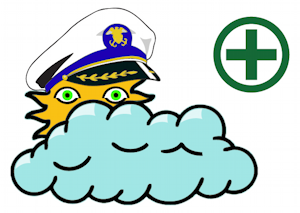 Weather Eye
Weather EyeEach player starts the game with a number of "Weather Eye" cards. He may place them anywhere on the playing surface at the end of his turn; the only restrictions are that the cards may not touch a boat, manoeuvre card or buoy, and that they must have a distance of at least one ruler length from Weather Eye cards already in play. The cards must be placed with either their short or their long side parallel to the wind; this affects their drifting speed.
The card has an influence zone with a radius of one ruler length that extends to any boat that can, at the start of its turn, place the Weather Eye Ruler in a way that it touches both the card and the boat or its manoeuvre card. Its influence gives an advantage in manoeuvring: You place the manoeuvre card normally, but then you may move it sideways as far as you wish, as long as the bow still points into the "+" zone on the card; the card must keep the same direction and may not be turned, you may only move it strictly sideways, thus shifting the entry point. The boat exits the card normally, which means that you gain a sideways movement advantage that is particularly valuable on close-hauled tacks, or to evade obstacles (see example below).
A boat can only get one Weather Eye advantage, even if it is under the influence of more than one card. It is not allowed to apply the ruler to check the influence zone beforehand, the only times you may use the ruler are when you place the card and when you actually move your boat in your turn.
The last player in the round moves all Weather Eye cards downwind by one or two full card lengths (his choice) after his turn, thereby ending the round; just flip the cards over the downwind edge once or twice. If the cards come into conflict with boats, manoeuvre cards, buoys etc. place it under the obstacle.
When a weather eye card exits the playing area, remove it from the game; it cannot be played again in this race.
 This example shows how to use weather eye cards and how to move them.
This example shows how to use weather eye cards and how to move them.
In effect, the bonus shift has enabled him not to drift downwind this turn.
At the end of the round, the player going last moves all weather eye cards. He flips all the cards over their leeward edge, i.e. to position (a) in our example; remember, the cards must be placed with one edge parallel to the wind line. Optionally, he may flip some or all cards once again (to position (b), in this example) if he thinks it will be to his advantage or at least to the disadvantage of someone else.
For free-form races you may consider to place fixed, nonmoving weather eye cards that represent wind changes on geographical features, like winds "bent" on capes etc.
The omission of "malus" cards was a conscious design decision to enhance playability. In other words, I couldn't come up with a good, easy rule for that.
Boats and the manoeuvre cards placed in front of them may never touch fixed obstacles like buoys, the start ship, land or boats dead in water. If a boat comes into a situation where it would violate this rule, it must stop one card length (short side) short of the obstacle and does not place a new movement card; it is "dead in the water" now (see there for details how to proceed).
Olympic Triangle – Trapeze – Up and Down – Free-Form
The following courses are typical for dinghy races. Nearly always the course starts with an upwind leg that requires tacking. Set the course up with a size that the up-wind leg is at least 10 times the card size you use. It is best to make a sketch of the course to be sure that all players have properly understood how to sail the course.
When you use small cards, make the upwind leg at least 6,7*10 cm = 67 cm; for standard playing cards, use at least 8,9*10 = 89 cm. Or any other size that pleases you and fits your playing surface.
You may want to restrict the playing surface if there are no natural restrictions.
The classic course, but not often used these days; probably it is too long for the average couch potato's attention span. This makes an excellent course for the game; however, playing a full Olympic triangle race may take some hours.
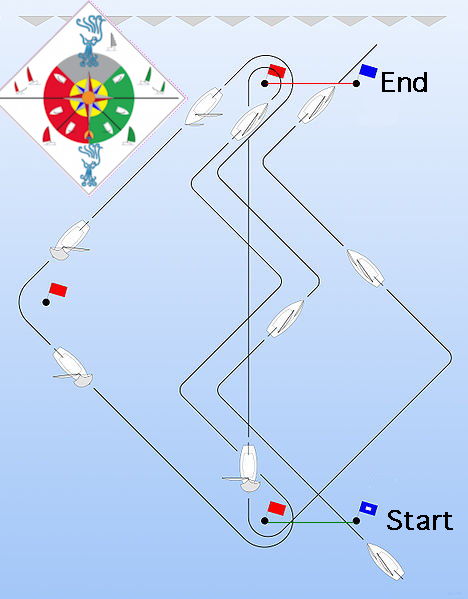
A simplified form of the Olympic triangle, with the advantage that two races can use the same water space more or less at the same time. (This "trapeze" is in the geometric, not the artistic sense and has nothing to to do with the dinghies' trapeze equipment.) Trapeze-shaped courses can be sailed as an "outer loop" (left image) or "inner loop" (right image) course. Use such a course if you do not have the time for the full triangle.
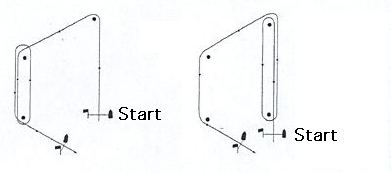
Simplified course, made popular by "match races", i.e. short and quick, KO-system, one-against-one races. You can run several such races in parallel even in modest water space.
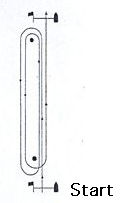
Anything goes; such courses often take the local environment into account and use islands or capes as elements in the race. For such races you may consider to create your own coasts and islands from cardboard. You could also place permanent weather eye markers at certain spots to simulate wind changes caused by geography.
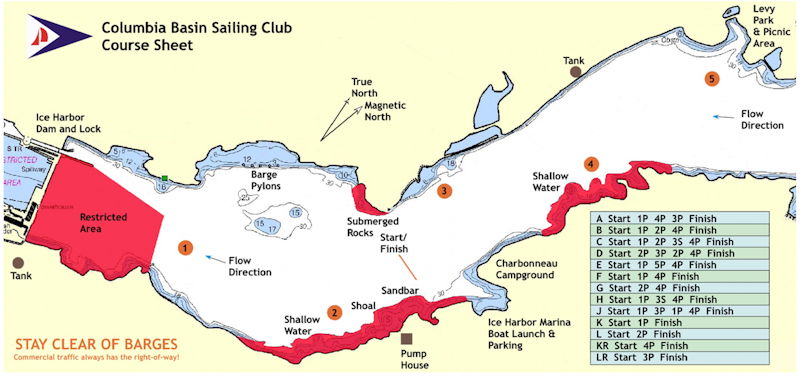
Example: Map of the 34th Annual Desert Regatta, hosted by the Columbia Basin Sailing Club Charbonneau Park, WA, USA. The numbered orange dots are the buoys; "1P" means "round buoy #1, port side", "3S" means "round buoy #3, starboard side". Note the start and finish line west of Ice Harbour marina.
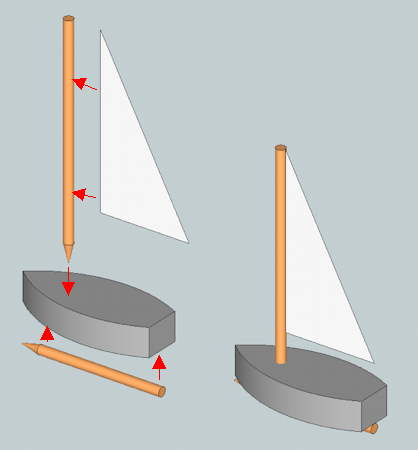 If you do not own one of the Regatta games mentioned in the game overview, you can easily make your own boats:
If you do not own one of the Regatta games mentioned in the game overview, you can easily make your own boats:
It would also not be very difficult to manufacture your boats from metal if you have some basic tools.
Just as a reference: The Gigamic boats are 6.2 cm hull length and 9.3 cm overall height, the 3M boats are 1.7 cm hull length and 3.1 cm overall height.
I certainly do not need to tell you how to improvise turn marker buoys.
Version 20110223 (see version history)
I want to thank the following people who helped me to develop this game, in addition to the credits given in the game overview and chronological order:
– The End –
As the author of this page I take no expressed or implied responsibility for the content of external links; opinions expressed on such pages are not necessarily mine. The web space provider is not responsible for the contents of this page or any linked pages.
Written and published by Lutz Pietschker. Please send comments about technical problems to the
site master.
-Made with a Mac!-
, last change 2011-03-12